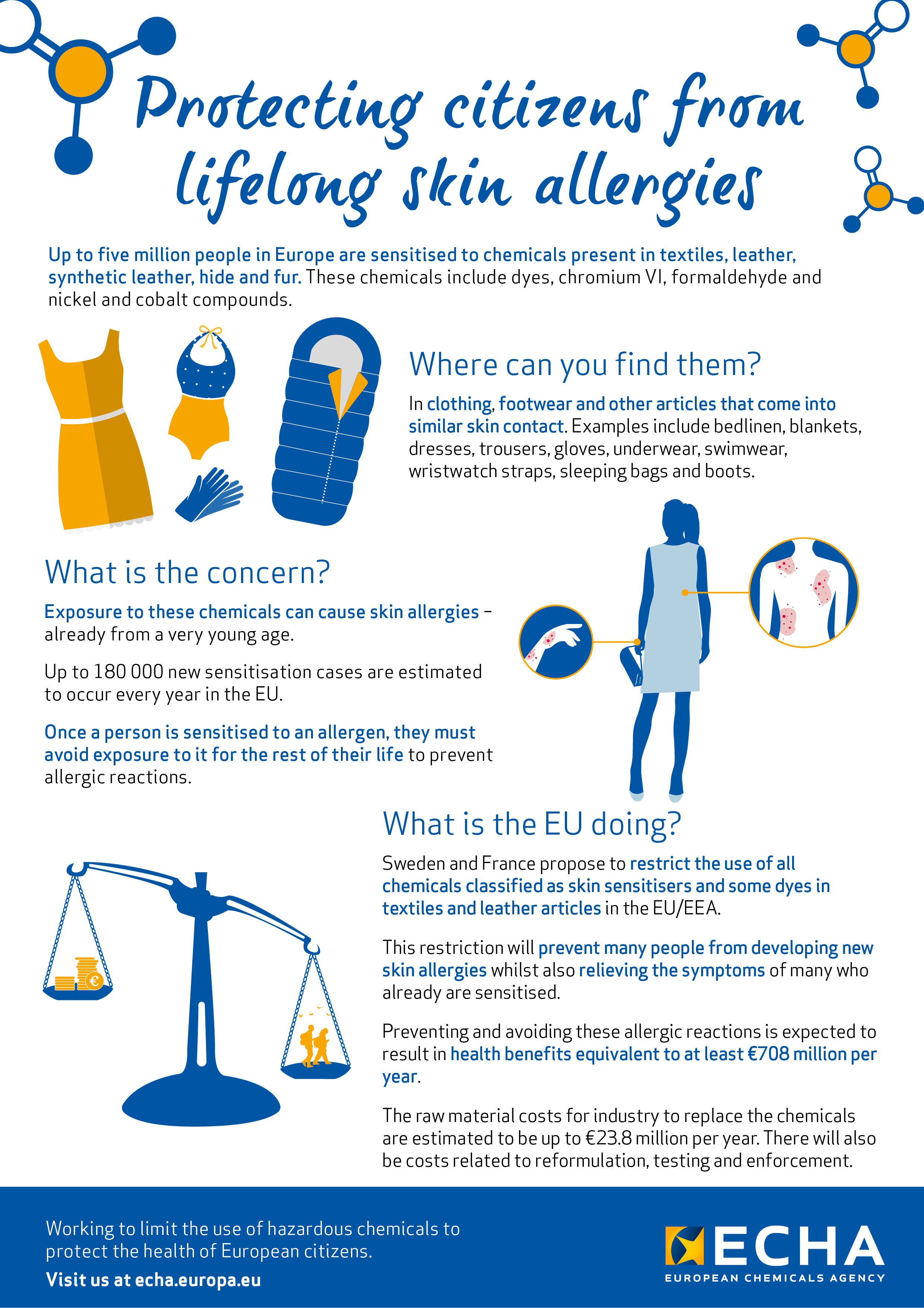All news
-
Pers
- Beeldengalerij
- Videobibliotheek
- Safer chemicals podcast
-
Actuele wetenschappelijke onderwerpen
- Kankerpreventie
- Huidsensibiliserende chemische stoffen
- Perfluoralkyl bevattende chemische stoffen (PFAS)
- Microplastics
- Rubberkorrels en -strooisel op sport- en speelvelden
- Tatoeage-inkten en permanente make-up
- Glyfosaat
- Hormoonontregelende stoffen
- Bisfenolen
- Strategie voor duurzame chemische stoffen
- Dierproeven in het kader van REACH
- Ftalaten
- Biocides
- Lood
- Research to enhance protection of our health and environment
- Corporate and visual Identity
- ECHA Articles
All news
ECHA’s committees back restricting over 1 000 skin sensitising chemicals used in clothing and other articles
ECHA/NR/20/29
The Committee for Socio-economic Analysis (SEAC) supports France and Sweden’s proposal to restrict the use of skin sensitising substances in clothing, footwear and other articles with similar skin contact. If adopted, the restriction will prevent many people from developing new skin allergies while also relieving the symptoms of many of those who already have them. This is expected to result in health benefits equivalent to at least €708 million per year.
Helsinki, 22 September 2020 – SEAC adopted its final opinion on France and Sweden’s proposal to restrict skin sensitising substances in textile, leather, synthetic leather, hide and fur articles, that are placed on the market for the first time. This follows an earlier opinion by the Committee for Risk Assessment (RAC) in March 2020. Both committees concluded that an EU-wide restriction is the most appropriate means to address the risks to EU citizens. In addition, SEAC concluded that the expected benefits and costs to society of the proposal mean that it is likely to be proportionate.
 |
| Click to view the infographic. |
Skin sensitisation is a health effect that leads to a lifelong sensitivity to a specific allergen. Currently, there is a growing concern about skin sensitisation from exposure to chemicals in textile and leather products: it is estimated that up to 5 million people in the European Economic Area are already sensitised and up to 180 000 new cases occur each year.
The proposed restriction covers substances that have a harmonised classification as skin sensitisers under the Classification, Labelling and Packaging (CLP) Regulation such as chromium VI, nickel and cobalt compounds. It also proposes to restrict some dyes that are considered to have skin sensitising properties, but which do not have a harmonised classification. The proposal introduces a link with the CLP Regulation meaning that any substance that is classified as a skin sensitiser in the future under CLP would automatically be covered by the restriction. When substances are automatically added to the restriction, SEAC recommends a transitional period of three years between classification and the conditions of the restriction taking effect to allow manufacturers to adapt.
If adopted by the European Commission, the restriction will prevent many new skin allergies while also relieving the symptoms of many people who already have them. This is expected to save European society at least €708 million a year in reduced healthcare costs, productivity losses (e.g. due to sick leaves) and welfare losses (in terms of reduced quality of life due to the allergy). The raw material costs for industry to replace the chemicals are estimated to be up to €23.8 million per year. There will also be costs related to reformulation, testing and enforcement.
Following SEAC’s adoption, the opinions of both RAC and SEAC as well as the proposal of France and Sweden will be sent to the European Commission, which will take the decision together with the EU Member States.
***
In their September meetings, RAC and SEAC also discussed applications for authorisation, other restriction proposals and harmonised classification and labelling. The main conclusions were:
- SEAC adopted its final opinion on ECHA’s proposal to restrict the placing on the market of calcium cyanamide used as a fertiliser. The proposed restriction is intended to protect aquatic and soil organisms in European surface waters and soils from the transformation products of calcium cyanamide.
- SEAC adopted its final opinion on ECHA’s proposal to restrict five cobalt salts. All five cobalt salts are classified as carcinogenic, mutagenic and reprotoxic (CMR). Currently, 35 000 EU workers are estimated to be exposed to these cobalt salts. The proposed restriction would help protect these workers from the risks associated with the salts.
- SEAC adopted its final opinion on ECHA’s proposal to restrict formaldehyde in articles, road vehicles and aircraft.
- SEAC also received an update on the consultation comments received on ECHA’s proposed restriction of intentionally-added microplastics. The 60-day consultation on SEAC’s draft opinion ended on 1 September 2020, with 211 comments received. SEAC is expected to adopt its final opinion in December 2020.
- Both committees adopted their opinions on applications for authorisation on 12 uses of octylphenol- and nonylphenol ethoxylates.
- RAC adopted 15 opinions on harmonised classification and labelling.
Full details about the committees’ conclusions are available in the annex.


